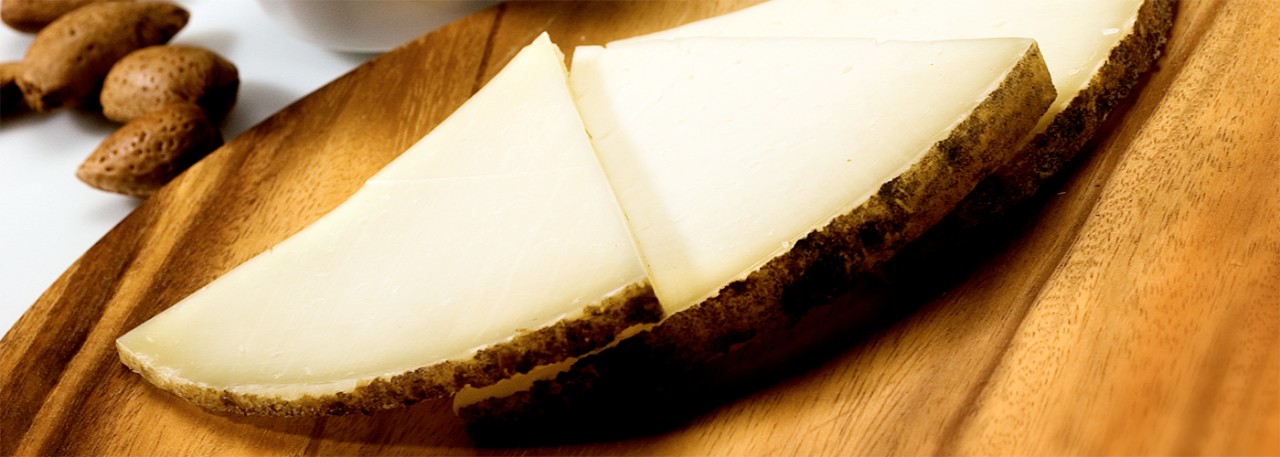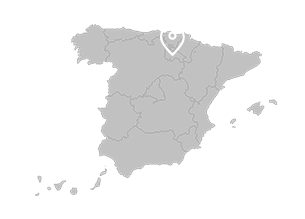.png.transform/rendition-xs/image_image%20(1).png)
Queso Camerano PDO
Goat’s milk cheese made from the Serrana, Murciana-Granadina, Malagueña, Alpina breeds and their cross-breeds, made with pasteurized or untreated milk and undergoing different periods of ageing depending on the type being made. A distinctive feature of Camerano cheese is its series of external marks, produced by the “cilla”, the molds used to shape the cheese; they are made from plaited cane and leave their imprints on the outside of the cheese.
Tasting notes
- Fresh Camerano cheese: the curd is white and glossy, with no holes, a smooth jellified texture, very soft and moist. It has a very well-rounded flavor, ranging from very sweet to quite acidic.
- Soft Camerano cheese: It has a clearly defined rind, with either no mold or some incipient mold growth. The curd varies from white to an ivory white color, a medium hard to soft texture and with no holes. It has an intense flavor with a hint of acidity.
- Semi-cured Camerano cheese. It has a clearly defined rind with greenish-brown mold growth on the outside. The curd varies from white to an ivory white color, a hard to medium hard texture. It has an intense, well-defined flavor with a hint of acidity.
- Cured Camerano cheese. The rind is clearly defined with mold growth on the outside, mainly a greenish-brown in color. The curd varies from white to ivory white in color, with a firm, hard texture, and either very few holes or none at all. It has an intense and well-defined flavor.
Other notes
- Fresh Camerano cheese:
Shape: flattened cylindrical, with marks from the “cillas” used as molds.
Size: varies.
Weight: between 200-800 g / 0.44-1.76 lb
Rind: practically none.
Dry extract: minimum 40%.
Fat in dry extract: minimum 35%.
Sodium chloride: maximum 1.5%.
pH: minimum 6.
- Soft Camerano cheese:
Shape: flattened cylindrical, with marks from the “cillas” used as molds.
Size: varies.
Weight: between 200-1200 g / 0.44-2.65 lb
Dry extract: minimum 40%.
Fat in dry extract: minimum 35%.
Sodium chloride: maximum 2%.
pH: 4.80-5.50.
- Semi-cured Camerano cheese.
Shape: flattened cylindrical, with marks from the “cillas” used as molds.
Size: varies.
Weight: between 200-1200 g / 0.44-2.65 lb
Dry extract: minimum 45%.
Fat in dry extract: minimum 50%.
Sodium chloride: maximum 3%.
pH: 4.90-5.60.
- Cured Camerano cheese.
Size: varies.
Weight: between 200-1200 g / 0.44-2.65 lb
Dry extract: minimum 55%.
Fat in dry extract: minimum 50%.
Sodium chloride: maximum 3%.
pH: 4.90-5.60.
Production / Processing method
-Straining: The milk is strained in the reception area of the cheese-making plant.
-Pasteurization: The milk undergoes a heating process taking it to 71.7 ºC / 161º F for 15 seconds, or other combinations of temperature and time authorized by the Regulatory Council.
-Addition of calcium chloride: Added at a maximum of 250 mg/kg of milk used.
-Addition of lactic acid-producing bacterial cultures (LABs).
-Setting: the milk is made to set using kid goat rennet, lamb rennet or industrial rennet.
Fresh and soft Camerano cheese: setting takes place at a temperature of between 32ºC and 38ºC / 89.6 and 100.4º F during a period of between 15 and 45 minutes.
Semi-cured and cured Camerano cheese. setting takes place at a temperature of between 29ºC and 38ºC / 84.2 and 111.4º F during a period of between 25 and 60 minutes.
-Cutting. Once the curds have been obtained they are subjected to successive cuts until the grains are the desired size.
Fresh and soft Camerano cheese: grains of approximately 4 to 5 mm in diameter.
Semi-cured and cured Camerano cheese: grains of approximately 4 to 5 mm in diameter.
Washing the curds: this is optional.
-Reheating. This is optional, but if it is done, it is carried out on semi-cured and cured cheeses and consists of raising the temperature from 2ºC to 5ºC / 35.6º F to 41ºF higher than the setting temperature.
-Working the grains: The grains are stirred until they take on the required consistency.
Fresh and soft Camerano cheese: the grains are lightly worked, giving them a soft consistency.
Semi-cured and cured Camerano cheese: the grains are worked vigorously, giving them a hard consistency.
-Molding. After draining the serum, molding is done by placing the curds in cylindrical cake-shaped molds (if muslin is being used) or cylindrical molds with micro perforations (with or without muslin), of the correct size to ensure that the aged cheese acquires its distinctive shape, size and weight.
The term “cilla” refers to the plaited cane molds that were used in bygone times to make Camerano cheese. Nowadays they are made of plastic, but they retain their traditional shape.
-Pressing: once the curds have been placed in the molds, they are pressed using gravity or another process until the correct pH is obtained.
Fresh and soft Camerano cheese: if pressing is done at all, it is short and not very strong.
Semi-cured and cured Camerano cheese: pressing is carried out for between 1 and 4 hours until the correct pH is obtained.
-Salting: The cheese is salted by immersing the piece in fresh brine made with sodium chloride. The brine is kept at a concentration of between 15º Be and saturation. The cheese can remain in the brine for a maximum of 15 hours, depending on the concentration of the brine, the size of the cheese and the temperature, which must be below 20 ºC / 68º F.
-Ripening. During the ripening period the cheeses are turned and cleaned, plus the appropriate treatments are applied to the outside of the cheese. Throughout the entire process, the ripening chambers are kept at a relative humidity of over 80% and temperature that varies from between 9 and 15ºC.
-Storing-ageing: this is done from between 5 and 10 ºC / 41º and 50º F.
-Presentation for sale: soft, semi-cured and cured cheeses are presented for sale with their natural rind and placed in shrink film packaging, vacuum packed, placed in a paper bag or wrapped in cellophane.
Fresh cheeses are presented in tubs or thermoformed containers; this packaging may also be used for the soft cheeses. Cheeses undergoing a prolonged ageing process may also be treated by wiping the rind with olive oil. The cheeses are always sold as a single, complete piece.
Geography / Relief and climate
The area covered by this Designation of Origin is characterized by its abundance of good quality grazing pasture, plus a range of farming by-products obtained from this activity, which is a very important part of life in the valleys of La Rioja. Goats are the animals best suited to making full use of grazing pasture land plus anything that is left over from crop harvesting, and their physique means they can access hard to reach places that would be impossible for other species such as sheep and cows. Goats will happily eat low-growing herbs, shrubs and woodland vegetation, all of which make up a large percentage of natural pasture land in the region of La Rioja.
La Rioja is in the river Ebro basin, lying between the Cordillera Ibérica mountain range to the south and the Ebro to the north. The region is divided into two natural areas:
- The first and lower area lies along the river Ebro at an altitude of under 600 m / 1968 ft, and consists of tertiary terraces, vineyards and farming land; it is inhabited by 80% of the population.
- The second area lies at an altitude of 600 m / 1968 ft and upwards, consisting of mountainous terrain bordering the provinces of Soria and Burgos to the south on the peaks of the Sistema Ibérico mountain range, and with two well-defined areas: the northern end, occupying the south of the province, with rugged mountains and a narrow valley carved by the river Najerilla, which separates the Sierra de la Demanda from the Picos de Urbión and Sierra Cebollera mountain ranges, covered with beech, oak and pine forests that thrive thanks to the influence of the Atlantic Ocean and the high altitude; and the southern end, in the Sierra de Cameros, a series of mountains descending towards the Ebro and crossed by the Cidacos, Leza, Iregua and Najerilla rivers.
The entire region of La Rioja is dominated by a Mediterranean climate. This is split within the province into 4 types: (I) temperate continental Mediterranean, (II) temperate Mediterranean, (III) cool temperate Mediterranean, and (IV) cold temperate Mediterranean. The first, temperate continental Mediterranean, affects the eastern low-lying half of the province, more or less below 600 meters. Climate II, temperate Mediterranean, has its area of influence in the north-western areas of the province and along the northern edge of the Cordillera Ibérica mountain range.
Climates III, cool temperate Mediterranean, and IV, cold temperate Mediterranean, govern most of the rest of the Cordillera Ibérica mountains, with the cold climate affecting the areas at the highest altitudes (Sierra de la Demanda, Sierra de Urbión and Sierra de Cebollera mountain ranges).
The climate conditions provide rich natural and ground cover pasture land, which is excellent for grazing and give the milk a series of distinctive features that directly affect its flavor, plus its fat, protein, sugar and mineral salt content, giving the cheese its own set of characteristic sensory properties.
Regulatory Council
Consejo Regulador de la DOP Queso Camerano
C/ Los Nogales, parc 55-56-57
Polígono Industrial Fuente Ciega
26200 Haro (La Rioja)
Tel.: (+ 34) 941 304 721
info@quesocamerano.com
www.quesocamerano.com
Sources:
- Spanish Ministry of Agriculture
Cheeses undergoing a prolonged ageing process may also be treated by wiping the rind with olive oil. The cheeses are always sold as a single, complete piece.


- PDO Queso Camerano
- PDO Queso Camerano Log

Haro (La Rioja)
